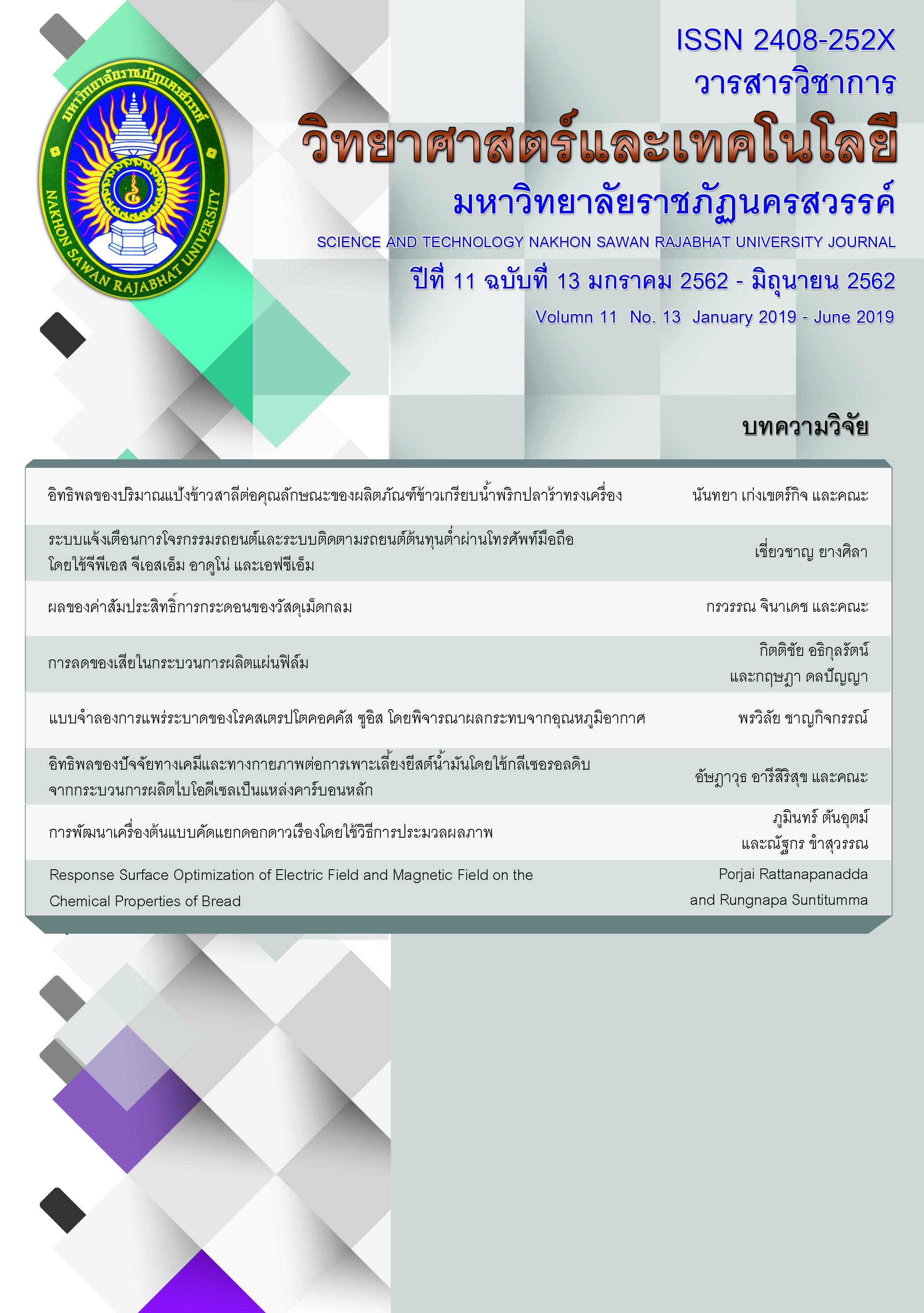อิทธิพลของปริมาณแป้งข้าวสาลีต่อคุณลักษณะของผลิตภัณฑ์ข้าวเกรียบน้ำพริกปลาร้าทรงเครื่อง
Main Article Content
Abstract
The development of Thai cracker combined with the spicy fermented fish paste results in the new flavored cracker that quite different from the traditional flavored crackers in market. In order to achieve the good quality of this cracker, the influence of wheat flour content replacement which are 0, 5, 10, 20 and 30 percent of tapioca flour on the characteristics of the cracker was studied. The results showed that wheat flour content had a significant effect on physical and chemical characteristics of the raw and fried crackers. The color of raw crackers was more opaque while the aw value and the moisture content of cracker were decreased when increasing wheat flour content. For fried crackers, the color of each sample also revealed more white and opaque when adding wheat flour content. Increasing wheat flour content, the aw value the moisture content and the expansion ratio of fried samples were decreased. The morphology of fried cracker when adding wheat flour also showed the reduction of the air cell size while the amount of air cell was increased which was resulting to the increasing of cracker hardness. For the sensory evaluation by 30 untrained panelists, the cracker with 5%WF was higher overall score than that of 10%WF, 20%WF, 0%WF และ 30%WF, respectively.
Article Details
References
จุฑามาศ ถิระสาโรช. (2552). ผลิตภัณฑ์จากเนื้อสัตว์. พิษณุโลก: สาขาวิชาเทคโนโลยีการอาหาร มหาวิทยาลัยเทคโนโลยีราชมงคลล้านนา.
จันทร์เพ็ญ ไชยนุ้ย. (2549). ผลของสมบัติทางเคมีของแป้งผสม (แป้งมันสำปะหลัง และแป้งสาคู) ต่อคุณภาพของข้าวเกรียบ. (วิทยานิพนธ์ปริญญา มหาบัณฑิต). มหาวิทยาลัยสงขลานครินทร์,คณะอุตสาหกรรมเกษตร, สาขาเทคโนโลยีอาหาร.
จริยากร ลิ่งไธสง, อรุณรัตน์ พิ้นผา, รินดา พวงพลอย และพรทวี ธนสมบัณณ์. (2551). การศึกษา กระบวนการผลิตข้าวเกรียบสับปะรดเสริมสมุนไพร. วารสารการเกษตรราชภัฎ, 7 (1): 10–24.
ชมภู่ ยิ้มโต, อภิญญา พุกสุขสกุล และอรวรรณ พึ่งคำ. (2555). การพัฒนาผลิตภัณฑ์ข้าวเกรียบธัญพืช. รายงานผลโครงการงบประมาณผลประโยชน์ปี 2555. ปทุมธานี: สาขาวิชาอาหารและโภชนาการ คณะเทคโนโลยีคหกรรมศาสตร์ มหาวิทยาลัยเทคโนโลยีราชมงคลธัญบุรี.
ดนัย เนียมหอม และอนุพงศ์ ยอดเพชร. (2559). อิทธิพลของปริมาณแป้งข้าวสาลีและน้ำพริกต่อสมบัติทางกายภาพและทางเคมีของข้าวเกรียบน้ำพริก (ไทย). (วิทยานิพนธ์ปริญญาบัณฑิต). มหาวิทยาลัยเทคโนโลยีราชมงคลล้านนา, คณะวิทยาศาสตร์และเทคโนโลยีการเกษตร, สาขาวิทยาศาสตร์และเทคโนโลยีการอาหาร.
เทวี ทองแดง. (2545). ผลของแรงบีบอัดและปริมาณอะไมโลสต่อการพองตัวของข้าว. รายงานการวิจัยทุนอุดหนุนการวิจัยจากงบประมาณรายได้ปี 2545. สงขลา: ภาควิชาวิทยาศาสตร์การอาหารและโภชนาการ คณะวิทยาศาสตร์และเทคโนโลยี มหาวิทยาลัยสงขลานครินทร์.
โนร์ฮามีมี คีรี. 2558. การศึกษาสมบัติทางเคมีของข้าวเกรียบปลาสดทอดที่เติมสมุนไพร ผสมข่า ตะไคร้ ใบมะกรูด และพริกขี้หนู. วารสารมหาวิทยาลัยนราธิวาสราชนครินทร์, 7 (2): 129–136.
ปิยภรณ์ สุริยะ, ณิชมน ธรรมรักษ์, สุปราณี แก้วเทียน, ริมฤทัย โภคารัตน์ และกรผกา อรรคนิตย์. (2554). การพัฒนาผลิตภัณฑ์ข้าวเกรียบถั่ั่วแปจ่อ. การประชุมวิชาการและนำเสนอผลงานวิจัยระดับชาติ แม่โจ้–แพร่ วิจัย ครั้งที่ 2. แพร่: มหาวิทยาลัยแม่โจ้-แพร่ เฉลิมพระเกียรติ.
ปราณี อ่านเปรื่อง. (2547). หลักการวิเคราะห์อาหารด้วยประสาทสัมผัส. กรุงเทพมหานคร: สำนักพิมพ์จุฬาลงกรณ์มหาวิทยาลัย.
เพลินใจ ตังคณะกุล. (2546). การทำข้าวเกรียบเป็นผลิตภัณฑ์คุณภาพ. วารสารอาหาร, 33 (2): 90–93.
รุ่งนภา พงษ์สวัสดิ์มานิต. (2543). การวิเคราะห์กระบวนการเจลาติไนเซชันและการเกิดรีโทเกรเดชันที่มีผลต่อการพองตัวของผลิตภัณฑ์ขนมขบเคี้ยวจากข้าว. วิทยานิพนธ์ปริญญาโท มหาวิทยาลัยเกษตรศาสตร์, กรุงเทพมหานคร.
สำนักงานมาตรฐานผลิตภัณฑ์ชุมชน. (2546). มาตรฐานผลิตภัณฑ์ชุมชน มผช. 107/2546 ข้าวเกรียบ. กรุงเทพมหานคร: กระทรวงอุตสาหกรรม.
หนังสือพิมพ์แนวหน้า. (2559). ข้าวเกรียบตะวันปรับแบรนด์ครั้งใหญ่. สืบค้นจาก https://www.naewna.com/relation/204095?fb_comment_id=1061135913930580_1064741403570031
อรนุช สีหามาลา, ศุภชัย ภูลายดอก และพนอจิต ซองศิริ. (2546). การศึกษาสูตรที่เหมาะสมของข้าวเกรียบใบหม่อน. กาฬสินธุ์: รายงานวิจัย คณะวิชาเทคโนโลยีการอาหาร สถาบันเทคโนโลยีราชมงคล วิทยาเขตกาฬสินธุ์.
AOAC. (2000). Association of official analytical chemists. official method of analytical. 17th ed. Maryland: Gaithersburg, Md.: AOAC international.
Aqua Lab Inc. (2016). Aqualab point water activity meter “seeds”. Retrieved from www.aqualab.com/products/water-activity-meters/aqualab-dew-point-water-activity-meter-4te/
Colonna, P., Tayeb, J
. & Mercier, C. (1989). Extrusion cooking of starch and starchy products. Minnesota: The American association of cercal chemists.
Kyaw, Z.Y., Cheow, C.S. & Dzulkifly, M.H. (2001). The effect of pressure cooking on the microstructure and expansion of fish cracker. Journal of Food Quality, 24: 181–194.
Mohamed, S., Abdullah, N. & Muthu, M.K. (1988). Physical properties of keropok (fried crisps) in relation to the amylopectin content of starch flour. Journal for Agriculture and Food Chemistry, 49: 369 - 377.
Yu, S.Y., Mitchell, J.R. & Abdullah, A. (1981). Production and acceptability testing of fish cracker prepared by the extrusion method. Journal of Food Technology. 16: 51–58.
Wang, R.D., Chiang, W.C., Zhao, B.L., Zheng, X. & Kim, I.H. (1991). Experimental analysis and computer simulation of starch water interaction. Journal of food science 56: 121–129.


